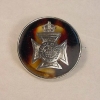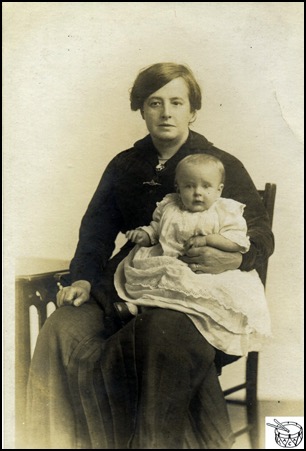A simple post today about a particular kind of Great War artifact: the sweetheart brooch.
 |
Sweetheart brooches are one aspect of the amazing array of insignia that civilians donned during the Great War. For example, I wrote some time ago about my own Needlework Guild Badge, a small symbolic brooch for textile volunteers. As wartime tokens of remembrance, sweetheart brooches symbolized relationships, pride, and served as a visual symbol of the constant stream of thoughts flowing between service-people and civilians. The below photograph, from the wonderful British Army Children's Archive, shows a mother and her baby. The woman, whose tightly clenched right fist (resting on her knee) and somewhat weary look seem to evidence fatigue, grief, and determination, wears a sweetheart brooch at the top center of her blouse.
 |
| WWI mother and child, with mother wearing a sweetheart brooch. © TACA |
A brooch wearer like the woman above reminded others who saw her of an important relationship, though her partner or relative was absent. I like to think, furthermore, that seeing the brooch on one's own clothing in the mirror or touching it, whether with an unintentional graze of the hand or purposeful contact, was part of a sweetheart brooch's emotional "technology." Many kinds of jewelry offer such transmissions of feeling or thought, whether helping to recall memories or gather, momentarily (as when we slide a locket along a necklace or caress a wedding ring), an expansive set of emotions. Are such gestures truly absent-minded? I don't think they can be entirely...
Sweetheart brooches came in many forms, often symbolizing a soldier's regiment and marrying romantic and military imagery. The Empire to Commonwealth Project's website has the widest collection of sweetheart brooch images I could find. From around the web, here are a few other examples:
 |
| WWI-era Royal Navy Sweetheart Brooch with mother-of-pearl backing. © Field Service Antique Arms and Militaria. |
 |
| Silver sweetheart brooch of the Liverpool Pals, n.d. © IWM, Item INS 6139. |
I hope you've enjoyed this little excursion through one of my own favorite aspects of WWI material history. This post concludes November's month of remembrance-themed writings. Next month I'll be looking at holidays and festivities on the front and at home. Thanks for reading and stay tuned!
© Fiona Robinson













